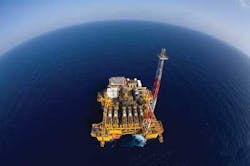Unconventional offshore gas—is it time?
What is the future of unconventional gas offshore? Will someone finally exploit some of the thousands of feet of organically rich shale beds we have beendrilling through for the past six decades in search of black gold? Is there another George Mitchell out there somewhere with the vision and the persistence to reevaluate some of those old wells in the Gulf of Mexico using modern interpretation methods to find some "sweet spots" with high total organic content (TOC)? The technology exists today to discover commercial shale gas that was there all along, but remained undiscovered by the technology available at the time.
To be sure, current gas prices do not provide much incentive to explore, especially offshore where everything costs more. However, it is not too difficult to envisage some short cuts that could shave millions of dollars off the cost of a few exploratory ventures from existing but no longer producing wells. For example, it may be possible to prove or disprove the presence of commercial volumes of unconventional gas offshore without drilling a single new well or side track, simply by reentering an existing well, but with modern technology.
For more than half a century, offshore logging engineers and geologists bemoaned the miles of "railroad tracks" (as shale logs were called) traversed while searching for deeper pay sands. At the time, no one examined those long shale intervals with the objective of looking for potential hydrocarbons. Everyone's attention was fixed on the potential reservoir sands. Of course, this was before the late Mitchell enlightened us to the possibility of commercially producible gas from massive shale source beds.
Recent history has provided several instances where entrepreneurial groups have reentered abandoned fields armed with modern logging instruments - tools with higher resolution and better precision - to find residual hydrocarbons of commercial potential. If these techniques are successful in traditional reservoir rocks, why not in marine shales?
New developments in logging tools have improved the quality and quantity of the data gathered while greatly reducing the risk. Nuclear logging tools that use electronic generators to produce high-energy neutrons have eliminated the requirement for chemical radioactive sources, along with the associated risk. Combining elastic and inelastic spectroscopy from greatly advanced detectors, up to 18 separate elements can be identified and quantified in open or cased holes, in water-based, oil-based, or synthetic-based fluids. With this rich spectrum of data, precise mineralogical interpretation can be performed to describe the most complex matrices. With dry weight elemental concentrations, matrix density, and mineral weight fractions can be determined. Total inorganic carbon weight fraction is determined, and when deducted from total carbon weight, the result is TOC. Petrophysical analyses can determine effective porosity.
The use of modern logging tools should provide a clearer picture of offshore shale intervals penetrated by offshore wells. In most cases, it would be the first time such data was available, because the tools did not exist when the wells were first drilled. Even if the tools existed, operators usually ran the bare minimum induction logs over the shale intervals, saving the more advanced logging tools for the pay sands. The opportunity to evaluate previously unlogged intervals with current technology instruments should energize even the most cynicalgeoscientist.
Interpretation software development has progressed by quantum leaps since the early days. Digital logs were only introduced in the 1960s, and advanced combination logging strings made their debut in the 1970s. So there may be thousands of under-evaluated wells today in the Gulf of Mexico. It is only logical to assume that the unconventional gas being discovered and produced onshore today exists offshore as well. Combining existing 3D seismic, modern logs, and computer-based reservoir modeling with today's interpretation software might reveal vast quantities of untapped energy in the form of unconventional offshore gas.
Once discovered, a potential unconventional play could be exploited by drilling side tracks from existing wells to tap the reservoir sweet spots identified by the logs. At this point, offshore operators could benefit from the advantage of an unlimited water supply to use in hydraulic fracturing. What has been the bane of onshore operators could be the boon of those wishing to stimulate their offshore well. Stimulation companies have already determined that they can use sea water in their fluid designs. It is likely that post fracturing flowback fluid would have to be processed before returning it to the sea but the technology exists to do this.
Production economics already show the feasibility of commercial offshore gas operations. The Independence Hub currently has the capacity to serve 16 conventional offshore gas fields operated by different production companies by accepting their gas, processing it, and transporting it to shore by pipeline. As long as volumes are high enough, centralized production facilities like Independence Hub have proved to be economical. In any scheme launched to evaluate the overall feasibility of unconventional gas production from offshore wells, it might be possible to tieback to an existing facility that was equipped to accept and process natural gas so the system could be trialed without committing to a new production facility.
Shale gas pioneer George Mitchell did the heavy lifting, devoting years of his life and investing millions in a venture most considered to be folly. Is there not another visionary out there who will take up the standard, and pursue the prize that surely lies beneath the sea?


